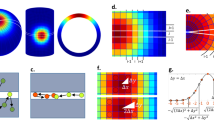Abstract
We introduce a simplified technique for incorporating diffusive phenomena into lattice-gas molecular dynamics models. In this method, spatial interactions take place one dimension at a time, with a separate fractional timestep devoted to each dimension, and with all dimensions treated identically. We show that the model resulting from this technique is equivalent to the macroscopic diffusion equation in the appropriate limit. This technique saves computational resources and reduces the complexity of model design, programming, debugging, simulation and analysis. For example, a reaction-diffusion simulation can be designed and tested as a one-dimensional system, and then directly extended to two or more dimensions. We illustrate the use of this approach in constructing a microscopically reversible model of diffusion-limited aggregation as well as in a model of growth of biological films.
Similar content being viewed by others
REFERENCES
E. S. Boek, P. V. Coveney, H. N. W. Lekkerkerker, and P. van der Schoot, Simulating the rheology of dense colloidal suspensions using dissipative particle dynamics, Phys. Rev. E 55:312–3133 (1997).
B. M. Boghosian, F. J. Alexander, and P. V. Coveney, eds., Proceedings of the sixth international conference on discrete models for fluid mechanics, Int. J. Mod. Phys. C 8(4) (1997).
G. H. Weiss, Aspects and Applications of the Random Walk (North-Holland, Amsterdam, 1994).
J. Hardy, O. de Pazzis, and Y. Pomeau, Molecular dynamics of a classical lattice gas: Transport properties and time correlation functions, Phys. Rev. A 13(5):194–1961 (1976).
U. Frisch, B. Hasslacher, and Y. Pomeau, Lattice-gas automata for the Navier-Stokes equation, Phys. Rev. Lett. 56(14):150–1508 (1986).
N. Margolus, T. Toffoli, and G. Vichniac, Cellular-automata supercomputers for fluiddynamics modeling, Phys. Rev. Lett. 56(16):169–1696 (1986).
N. H. Margolus, CAM-8: A computer architecture based on cellular automata, in Pattern Formation and Lattice-Gas Automata, A. Lawniczak and R. Kapral, eds., American Mathematical Society (1996).
D. H. Rothman and S. Zaleski, Lattice-Gas Cellular Automata: Simple Models of Complex Hydrodynamics (Cambridge University Press, Cambridge, UK, 1997).
J. P. Rivet and J. P. Boon, Lattice Gas Hydrodynamics (Cambridge University Press, Cambridge, UK, 2000).
D. A. Wolf-Gladrow, Lattice-Gas Cellular Automata and Lattice Boltzmann Models: An Introduction, Lecture Notes in Mathematics (Springer-Verlag, New York, 2000).
R. Kapral, A. Lawniczak, and P. Masiar, Oscillations and waves in a reactive lattice-gas automaton, Phys. Rev. Lett. 66(19):253–2542 (1991).
J. P. Boon, D. Dab, R. Kapral, and A. Lawniczak, Lattice gas automata for reactive systems, Phys. Rep. 273(2):5–147 (1996).
T. Toffoli and N. H. Margolus, Cellular Automata Machines: A New Environment for Modeling (MIT Press, Cambridge, MA, 1987).
M. A. Smith, Cellular Automata Methods in Mathematical Physics, Ph.D. thesis (Massachusetts Institute of Technology, 1994).
R. M. D'Souza, Macroscopic Order From Reversible and Stochastic Lattice Growth Models, Ph.D. thesis (Massachusetts Institute of Technology, 1999).
N. H. Margolus, Crystalline computation, in Feynman and Computation, A. Hey, ed. (Addison-Wesley, 1998).
W. F. Ames, Numerical Methods for Partial Differential Equations, 2nd ed. (Academic Press, New York, 1977).
W. H. Press, S. A. Teukolsky, W. T. Vetterling, and B. P. Flannery, Numerical Recipes in C: The Art of Scientific Computation, 2nd ed. (Cambridge University Press, Cambridge, 1992).
T. Toffoli, Three-dimensional rotations by three shears, Graphical Models and Image Processing 59:8–96 (1997).
O. L. Bandman, Comparitive study of cellular-automata diffusion models, in Lecture Notes in Computer Science, Vol. 1662, pp. 39–409 (1999).
P. V. Coveney, J. B. Maillet, J. L. Wilson, P. W. Fowler, O. Al-Mushadani, and B. M. Boghosian, Lattice-gas simulations of ternary amphiphilic fluid flow in porous media, Int. J. Mod. Phys. C 9(8):147–1490 (1998).
B. Chopard and M. Droz, Cellular automata model for the diffusion equation, J. Stat. Phys. 64(3/4):85–892 (1991).
B. Chopard and M. Droz, Cellular Automata Modeling of Physical Systems (Cambridge University Press, Cambridge, UK, 1998).
R. Byron Bird, E. N. Lightfoot, and W. E. Stewart, Transport Phenomena, 2nd ed. (John Wiley &; Sons, New York, 2001).
D. Walgraef, Spatio-Temporal Pattern Formation: With Examples from Physics, Chemistry, and Materials Science (Springer Verlag, New York, 1997).
H. C. Berg, Random Walks in Biology (Princeton University Press, Princeton, 1983).
J. Crank, The Mathematics of Diffusion, 2nd ed. (Oxford University Press, Oxford, 1975).
H. D. Chen, B. M. Boghosian, P. V. Coveney, and M. Nekovee, A ternary lattice Boltzmann model for amphiphilic fluids, Proc. Roy. Soc. London Ser. A 456:204–2057 (2000).
J. L. Lebowitz, Microscopic reversibility and macroscopic behavior: Physical explanations and mathematical derivations, In Lecture Notes in Physics, J. J. Brey, J. Marro, J. M. Rubi, and M. San Miguel, eds. (Springer, 1995).
D. Stauffer, Irreversible statistical mechanics from reversible motion: Q2R automata, Comput. Phys. Comm. 127(1):11–119 (2000).
N. Margolus, An embedded DRAM architecture for large-scale spatial-lattice computations, in The 27th Annual International Symposium on Computer Architecture, IEEE Computer Society, pp. 14–160 (2000).
T. A. Witten and L. M. Sander, Diffusion-Limited Aggregation, a kinetic critical phenomenon, Phys. Rev. Lett. 47(19):140–1403 (1981).
R. M. D'Souza and N. H. Margolus, Thermodynamically reversible generalization of diffusion limited aggregation, Phys. Rev. E. 60(1):26–274 (1999).
G. E. Pizarro, D. Griffeath, and D. R. Noguera, Quantitative cellular automaton model for biofilms, J. Environ. Eng. 127:78–789 (2001).
G. E. Pizarro, Quantitative Modeling of Heterogeneous Biofilms Using Cellular Automata, Ph.D. thesis (University of Wisconsin, 2001).
C. Carothers, K. Perumalla, and R. Fujimoto, Efficient optimistic parallel simulations using reverse computation, in ACM Transactions on Modeling and Computer Simulation, Vol. 9 (1999).
N. Nisan, Pseudorandom generators for space-bounded computation, Combinatorica 12(4):44–461 (1992).
J. Yepez, Lattice-gas crystallization, J. Stat. Phys. 81(1/2):25–294 (1994).
C. Appert and S. Zaleski, Lattice gas with a liquid-gas transition, Phys. Rev. Lett. 64 (1990).
Author information
Authors and Affiliations
Rights and permissions
About this article
Cite this article
D'Souza, R.M., Margolus, N.H. & Smith, M.A. Dimension-Splitting for Simplifying Diffusion in Lattice-Gas Models. Journal of Statistical Physics 107, 401–422 (2002). https://doi.org/10.1023/A:1014587326991
Issue Date:
DOI: https://doi.org/10.1023/A:1014587326991




